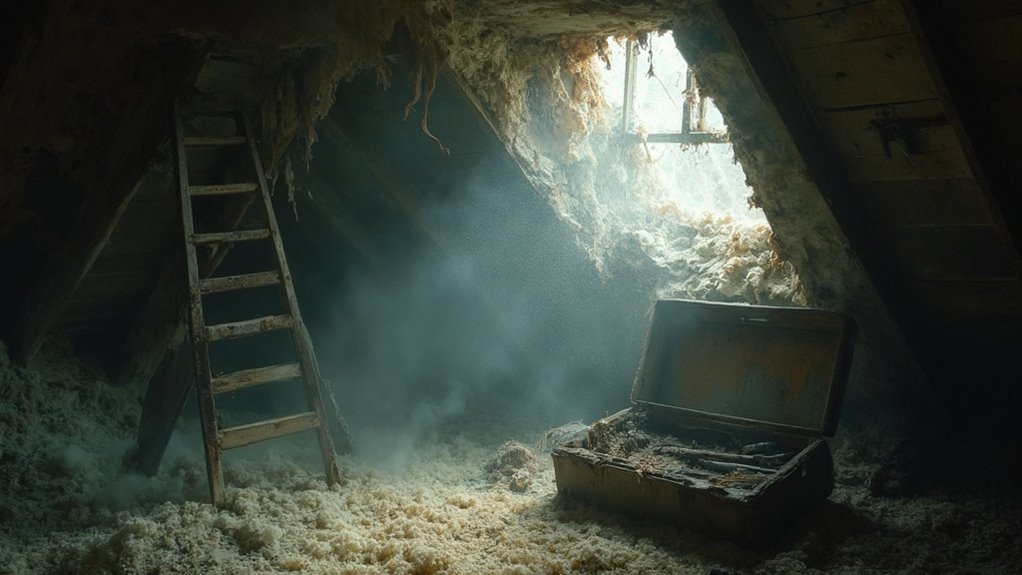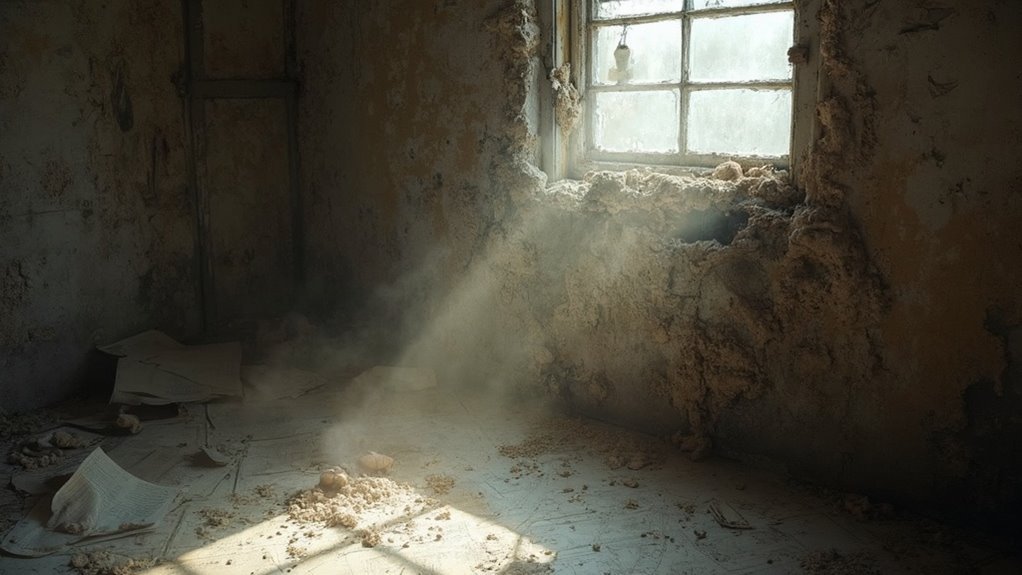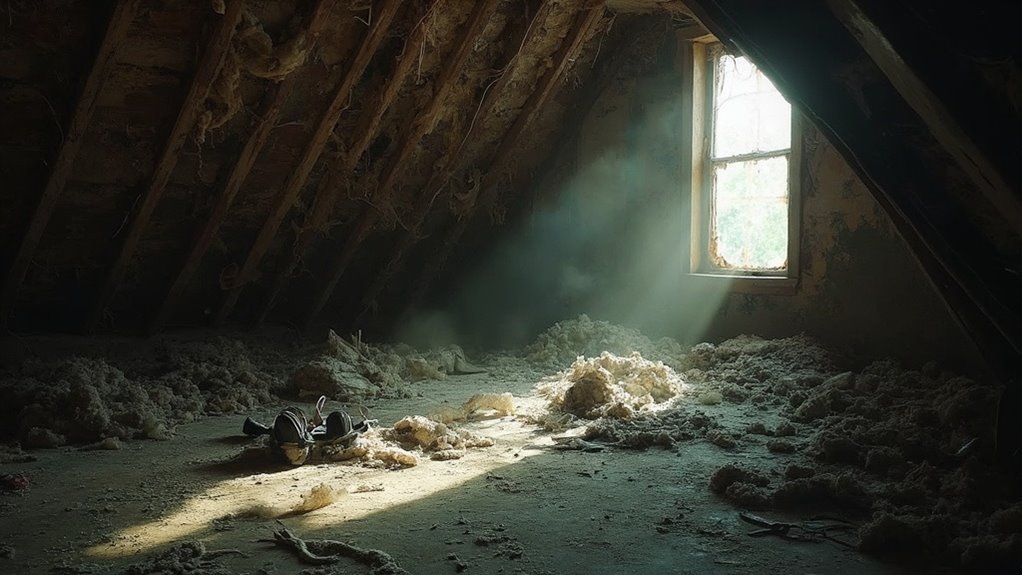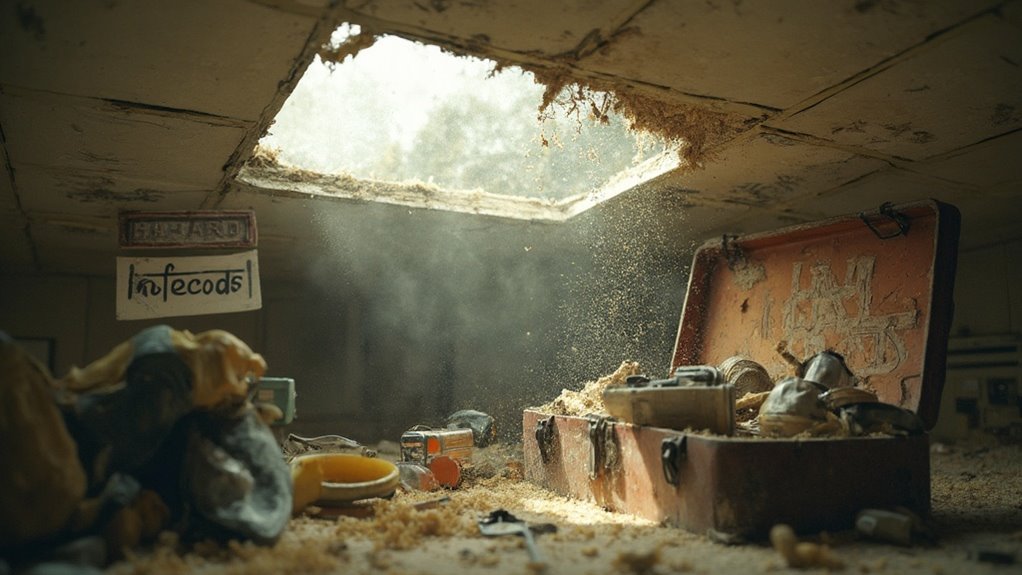Leaving asbestos in your home puts you and your family at serious risk. Even small disturbances can release harmful fibers, leading to severe health issues like lung cancer and mesothelioma, which may not surface until decades later. Homes built before the 1980s often contain asbestos in insulation, flooring, and pipes, making it vital to inspect your property. If you suspect asbestos, don't attempt to remove it yourself; instead, contact professionals for safe handling and removal. Understanding the dangers and proper management of asbestos is significant, and exploring further can provide you important steps to protect your home and health.
Understanding Asbestos Exposure Risks

Understanding the risks associated with asbestos exposure is fundamental for homeowners, especially since many older homes contain this hazardous material. Asbestos fibers can be released into the air during renovation or demolition activities, particularly in structures built before the 1980s. Materials like insulation, flooring, and pipes often harbor asbestos, and when these are disturbed—whether through drilling, sanding, or scraping—you increase your risk of exposure considerably. All asbestos fibers are harmful if breathed, making it essential to handle any suspected materials with caution. Additionally, compliance with regulations is critical to ensure safe management of asbestos in your home.
To comply with asbestos regulations, it's imperative to avoid disturbing undamaged materials. If you're planning any renovations, testing for asbestos is a necessary first step. Hiring trained professionals guarantees safe handling and removal of asbestos-containing materials, preventing exposure during the process. Additionally, keeping areas with potential asbestos restricted until experts assess them is crucial for exposure prevention.
Health Consequences of Asbestos
Asbestos exposure poses serious health risks that can have devastating consequences for individuals over time. When inhaled, asbestos fibers can lead to severe diseases such as lung cancer, mesothelioma, and asbestosis. You might not notice asbestos symptoms until years later, as these conditions often develop 20 to 50 years post-exposure. Asbestosis, characterized by scarring of lung tissue, can severely impair your lungs and heart's ability to deliver oxygen, leading to chronic breathing difficulties.
The risk of developing lung cancer greatly increases if you're a smoker exposed to asbestos, resulting in a "far greater-than-additive" risk. Nonmalignant disorders like pleural plaques and thickening as well arise, indicating potential complications from asbestos exposure. Unfortunately, no amount of asbestos is considered safe, and the health effects can be influenced by the duration and intensity of exposure. Understanding the health risks associated with asbestos is crucial for addressing potential threats in your home.
If you suspect you've been exposed, it's essential to seek an asbestos diagnosis from a healthcare professional. Early detection can be important in managing health outcomes. Ultimately, understanding these health consequences emphasizes the need for proactive measures in homes containing asbestos.
Identifying Asbestos in Your Home

Identifying asbestos in your home is essential for protecting your health and ensuring safety. To effectively identify asbestos, you can use various asbestos identification methods. Start by inspecting common locations such as attics, basements, ceilings, and floors. Pay special attention to materials like vermiculite attic insulation, vinyl floor tiles, and boiler insulation.
Visual indicators can help you recognize asbestos-containing materials. Look for fibrous materials, such as textured popcorn ceilings or corrugated paper wraps on pipes. Wavy patterns and chalky textures, often found in older homes, may likewise signal the presence of asbestos. Moreover, materials with wood grain designs or brittle, breakable properties are strong indicators.
Homes built between the 1940s and 1970s are particularly at risk, so evaluate the age and condition of your building materials. If you suspect asbestos, consider using DIY testing kits or hiring certified professionals for accurate testing. Proper identification is imperative, as it sets the stage for safe management or removal. Always prioritize safety and adopt precautions to prevent disturbance to suspected asbestos materials in your home.
Precautions to Prevent Exposure
To effectively prevent exposure to asbestos in your home, it's vital to prioritize professional inspections rather than attempting DIY testing. Following safe handling guidelines is fundamental to minimize risks during any necessary work. By adhering to these precautions, you can greatly reduce the likelihood of asbestos-related health issues.
Professional Inspections Recommended
Guaranteeing safety in your home often requires a keen awareness of potential hazards, and professional asbestos inspections play a crucial role in this process. By hiring trained professionals, you benefit from their expertise in accurately identifying asbestos-containing materials. These inspectors use specialized equipment to minimize the risk of asbestos fiber release, adhering to strict asbestos regulations throughout the inspection.
While inspection costs may vary, the investment is justified by the peace of mind it provides. Professionals conduct thorough assessments of all accessible areas of your home and deliver detailed reports with recommendations for necessary actions. They take precautions to minimize disruption during their work, guaranteeing your daily routine remains largely unaffected.
During these inspections, trained experts perform visual checks and may collect samples for laboratory analysis, always using protective gear to safeguard their health. By opting for professional inspections, you greatly reduce the risk of asbestos exposure and guarantee compliance with federal and state laws. Ultimately, this proactive approach not only protects your family but equally helps maintain the value of your home in the long run.
Avoid DIY Testing
When it comes to managing potential asbestos hazards in your home, relying on DIY testing kits can pose significant risks. One of the major DIY pitfalls is inadequate sampling techniques, which can lead to overlooked areas where asbestos is present. These kits often lack the sensitivity needed to detect low levels of asbestos fibers and may struggle to differentiate between asbestos and other materials. Furthermore, improper handling and inadequate sealing of samples can contaminate the testing environment and result in false negative results.
The potential for increased exposure further complicates DIY testing. Collecting samples can disturb asbestos-containing materials, releasing harmful fibers into the air. Homeowners typically lack the necessary protective equipment and expertise to safely collect samples, raising the risk of exposure during the process.
Moreover, the limitations of DIY kits must be acknowledged. They may not offer the precision of professional testing laboratories, often missing trace amounts of asbestos or yielding inaccurate results because of incompetent sample handling. Inaccurate testing accuracy can lead to underestimating health risks, leaving you vulnerable to severe health issues associated with long-term asbestos exposure. It's essential to avoid DIY testing and consult professionals instead.
Safe Handling Guidelines
Frequently, homeowners underestimate the significance of safe handling guidelines when dealing with asbestos. To protect yourself and others, start by informing your neighbors of the proposed work and advising them to close doors and windows. Confirm all vents are covered, and remove any personal belongings, play equipment, and vehicles from the work area. Cover the ground with heavy-duty plastic sheeting to catch dust and debris.
When working, wear appropriate personal protective equipment (PPE), including coveralls, gloves, and NIOSH-approved respirators. Verify all protective clothing is disposable or easily cleaned. Remember to wet down asbestos materials to minimize dust release and use non-powered hand tools to limit dust generation.
After completing the work, immediately double bag your protective gear in heavy-duty polythene bags. Shower and wash your hair to remove any lingering fibers, and clean the area thoroughly using wet methods and HEPA vacuums. Finally, dispose of any asbestos waste according to local asbestos regulations to confirm safe disposal. Following these guidelines is vital for minimizing exposure and maintaining a safe environment in your home.
Safe Handling and Removal Practices

Handling and removing asbestos safely requires meticulous preparation and adherence to established practices. You should start by wetting asbestos materials to minimize airborne fibers. Wearing NIOSH-approved respirators and protective clothing is critical. Use non-powered hand tools to avoid fiber dispersion, and always double-bag any waste.
Here's a quick overview of effective methods:
| Method | Description | Purpose |
|---|---|---|
| Wet Removal Method | Spray water mixed with a wetting agent | Reduces fiber release during removal |
| Glove Bag Method | Use a sealed bag with built-in gloves | Limits fiber release during handling |
| Encapsulation | Apply a sealant to asbestos materials | Prevents fiber release without removal |
| Enclosure | Construct airtight barriers | Contains fibers in larger areas |
These asbestos encapsulation techniques and the glove bag method are fundamental for safe handling. Always keep debris moist and avoid breaking materials to control fiber dispersion. After removal, conduct thorough clean-up and have a certified inspector verify the area. Proper disposal of waste is indispensable for safety.
Global Impact of Asbestos
As you consider the dangers of asbestos, it's vital to recognize its global impact, particularly regarding mortality rates. Each year, an estimated 200,000 people die as a result of asbestos exposure, highlighting the severe health risks associated with this material. Understanding these statistics can inform your decisions about safety and prevention in your own environment.
Worldwide Mortality Rates
The staggering global mortality rates associated with asbestos exposure reveal a critical public health crisis that demands attention. Asbestos statistics show that over 200,000 deaths occur annually because of occupational exposure. In 2019 alone, 239,330 lives were lost to diseases like asbestos-related lung cancer, mesothelioma, and asbestosis. These mortality trends indicate an alarming increase, with deaths rising from 107,000 in 2004 to over 209,000 in 2016.
What's particularly concerning is the long latency period of asbestos-related diseases, meaning the health impacts can persist for years, even after a country bans the substance. This delay contributes to ongoing mortality rates, particularly in regions where asbestos consumption remains high, often within developing countries.
Moreover, millions of metric tons of asbestos still exist in buildings and products worldwide, creating a continuous risk for exposure. As you evaluate the dangers of leaving asbestos in your home, the grim reality of these mortality rates underscores the urgency for action. Understanding these statistics can empower you to make well-informed choices about your health and safety.
Occupational Exposure Risks
Occupational exposure to asbestos poses a significant threat to workers across various industries, highlighting a persistent global health crisis. In spite of existing asbestos regulations, many occupations remain at risk owing to historical and ongoing exposure. Construction workers, auto mechanics, and electricians are particularly vulnerable, often encountering asbestos in materials like insulation and roofing tiles.
The health impacts are severe, with asbestos exposure linked to mesothelioma, lung cancer, and asbestosis. Importantly, mesothelioma is a rare but aggressive cancer that typically develops 10 to 50 years post-exposure, affecting thousands each year. Alarmingly, over 70% of work-related cancer deaths are attributed to asbestos, underscoring the urgent need for improved workplace safety measures.
While the prevalence of asbestos-related diseases is expected to decrease because of reduced exposure since the 1980s, approximately 1.3 million workers in the U.S. still face risks today. To protect yourself and your colleagues, it's vital to adhere to safety protocols and advocate for stricter regulations. By staying informed and proactive, you can help mitigate the dangers of asbestos exposure in your workplace and contribute to a healthier future.
Steps to Reduce Future Risks

Reducing future risks associated with asbestos in your home starts with proactive measures and educated choices. Conducting a thorough risk assessment is your first step. Regularly inspect any asbestos-containing materials, focusing on signs of wear or damage. If you find any issues, limit access to those areas immediately to prevent disturbances.
Implement preventive strategies by leaving undamaged materials alone and minimizing activities in affected areas. Avoid actions that might disturb asbestos, such as drilling or scraping. When handling any asbestos-containing materials, use protective equipment, but it's best to hire trained professionals for any repair or removal tasks. They'll guarantee proper containment and comply with local regulations during the process.
Don't vacuum or sweep debris that might contain asbestos—this can release harmful fibers into the air. Inform family members, home inspectors, and real estate agents about known asbestos risks to promote awareness. Finally, make it a routine to conduct regular inspections and maintenance on your home to prevent future deterioration. By taking these steps, you safeguard your health and that of others while effectively managing the risks associated with asbestos exposure.
Frequently Asked Questions
Can I Sell a Home With Asbestos Safely?
You can sell a home with asbestos safely by ensuring proper asbestos disclosure. Be aware that it may impact property value, so address potential buyer concerns and consider professional assessments to enable a smoother transaction.
How Can I Tell if My Home Has Asbestos?
To determine if your home has asbestos, schedule a professional home inspection. They'll conduct asbestos testing on materials like insulation and flooring, ensuring accurate identification while minimizing risks associated with improper handling.
What Are the Costs of Professional Asbestos Removal?
When considering asbestos removal services, costs typically range from $5 to $150 per square foot, depending on location and type. Asbestos testing adds initial expenses, but professional removal guarantees safety and regulatory compliance.
Are There Alternatives to Asbestos in Home Construction?
Imagine building a safer home. You've got plenty of asbestos alternatives like cellulose fiber and fiber-cement roofing. These safe materials not only protect your health but additionally improve your home's sustainability and durability.
How Long Do Asbestos Fibers Remain Airborne?
Asbestos fibers can remain airborne for 4 to 80 hours, depending on factors like room size and ventilation. Understanding airborne duration is vital to minimizing asbestos exposure and ensuring a safer environment for you.
